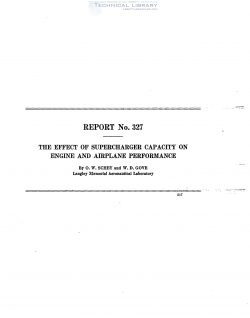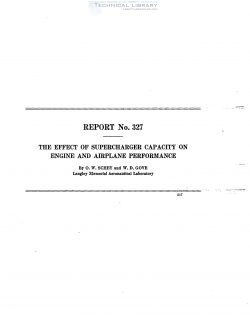naca-report-327

- Version
- 146 Downloads
- 1.57 MB File Size
- 1 File Count
- August 25, 2016 Create Date
- August 25, 2016 Last Updated
National Advisory Committee for Aeronautics, Report - The Effect of Supercharger Capacity on Engine and Airplane Performance

Supercharging has already demonstrated its value as a means of improving the performance of
an airplane at moderate and high altitudes. In order to obtain a maximum increase in the, perform-
ance of an airplane designed to meet definite service reguirements, it is necessary that a supercharger
of the proper capacity be selected.
The efi’ect of difierent supercharger'capacities on the performance of an airplane and its engine
was investigated by the stafi' of the National Advisory Committee for Aermzautics at Langley Field,
Va. The tests were conducted on a DEX—Mi! airplane powered with a Liberty 1.9 engine. In this
investigation four supercharger capacities, obtained by driving a Roots type supercharger at 1.615,
I357, 2.4, and 3 times engine speed, were used to maintain sea level pressure at the carburetor to
altitudes of 7,000, 11,500, 17,000, and 22,000 feet, respectively.
The performance of the airplane in climb and in levelflight was determined for each of the four
supercharger drive ratios and for the unsupercharged condition. The engine power was measured
during these tests by means of a calibrated propeller
Although the results of this investigation are not conducive to general conclusions as to the
proper capacity or type of supercharger for use with all types of airplanes, the information collected
on the variation with altitude and supercharger capacity of such factors as carburetor air tempera-
tures, power required to drive the supercharger, and the net engine power is of value as a guide in the
selection of the most suitable supercharger capacity for airplanes having difi'erent performance
characteristics than those of the one tested.
Several interesting conclusions pertaining to the efi‘ect of the capacity of a Roots type super-
charger on the performance of this particular airplane have been drawn from the results of these tests.
It was found that very little sacrifice in sea-level performance was experienced with the larger
supercharger drive ratios as compared with performance obtained when using the smaller drive ratios.
| File | Action |
|---|---|
| naca-report-327 The Effect of Supercharger Capacity on Engine and Airplane Performance.pdf | Download |
Comment On This Post